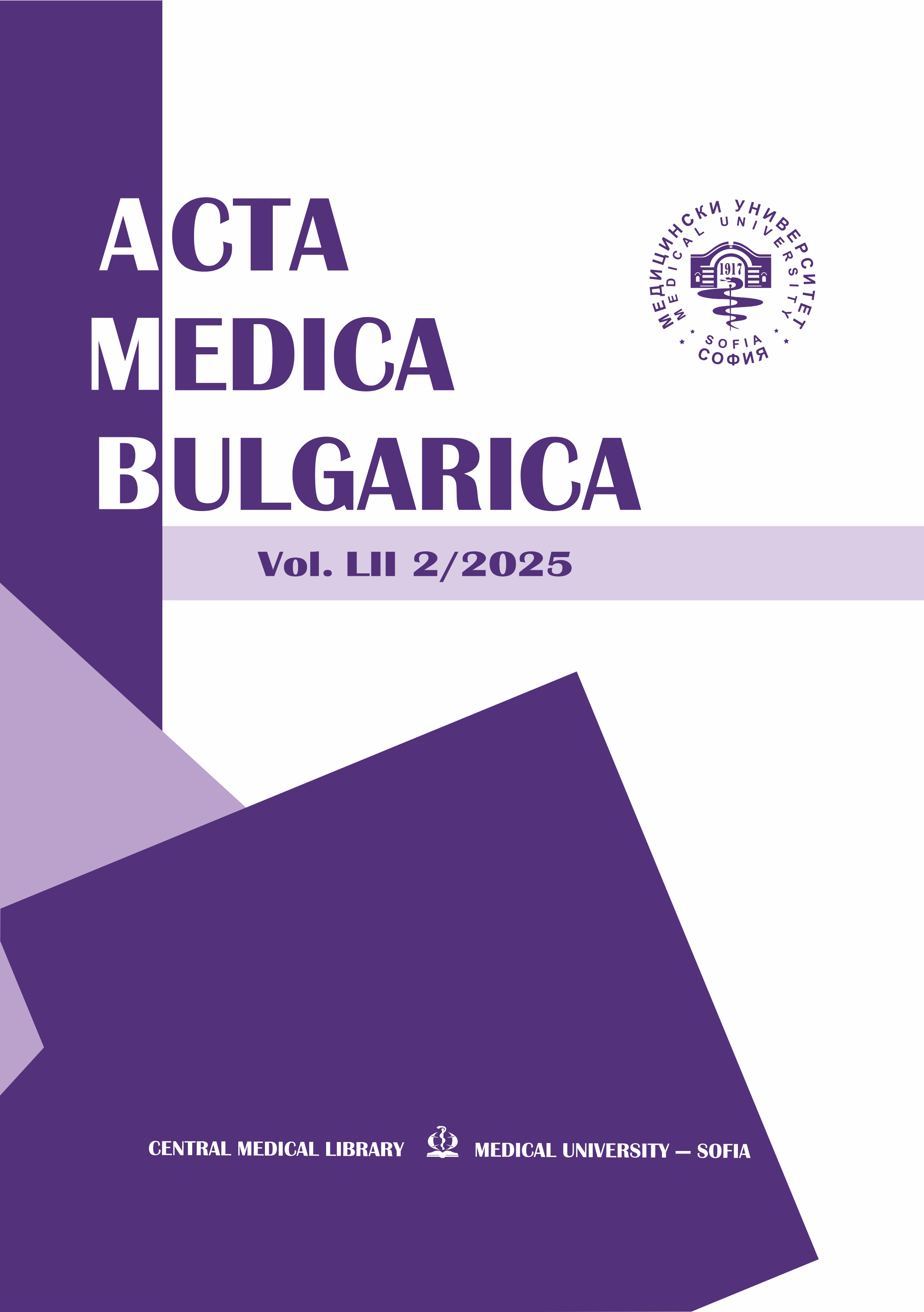Comprehensive clinico-demographic analysis of malignant pleural effusions in the bulgarian population: insights from an observational case-control study
DOI:
https://doi.org/10.2478/AMB-2025-0043Keywords:
pleural carcinomatosis, hydrothorax, demographic, clinical manifestation, malignant pleural effusionAbstract
Malignant pleural eff usions represent a signifi cant problem both from a clinical perspective and from a socioeconomic standpoint. They constitute a substantial burden on the healthcare system. Affecting approximately 1 million people each year, malignant pleural effusions are a leading cause of debilitating dyspnea and decreased quality of life for many patients. Distant metastasis to the pleural layers is one of the most common complications in many malignancies, with approximately 20% of cancer patients experiencing pleural eff usions during treatment. The average survival after diagnosis varies between 4 and 9 months, depending on the type and stage of neoplasm. This underscores the necessity for proper understanding of this pathology and the development of an appropriate diagnostic and therapeutic algorithm to address its consequences. To clarify the clinicodemographic aspects of malignant pleural eff usions, we carried out a one-year case-control observational study, which included patients of varying ages, clinical manifestations and primary etiologies. A total of 151 patients were included in the analysis. The control group consisted of 72 patients, all of whom were diagnosed with benign disease, confirmed by subsequent biopsy. Of these, 38 cases were confi rmed as infl ammatory, and 34 were verifi ed as pleural eff usions of non-infl ammatory origin. Malignant pleural involvement was confirmed in 79 patients. These two groups are representative of the main types of pleural pathology. We aimed to define the main characteristics of pleural malignancies and correctly recognize patients at risk.
References
Negrini D. Integration of capillary, interstitial and lymphatic function in the pleural space. In: Reed RK, McHale NG, Bert JL, Winlove CP, Laine GA, eds. Interstitium Connective Tissues and Lymphatics. London, Portland Press, 1995; 283-299.
Bernaudin JF, Fleury J. Anatomy of the blood and lymphatics circulation of the pleural serosa. In: Chretien J, Bignon J, Hirsh A, eds. The Pleura in Health and Disease.
Balasingam N, Thirunavukarasu K, Selvaratnam G. Etoricoxib-induced pleural effusion: A case for rational use of analgesics. J Pharmacol Pharmacother. 2015 Oct-Dec;6(4):231-2. doi: 10.4103/0976-500X.171876.
Stelzner TJ, King TE, Antony VB, Sahn SA. Pleuropulmonary manifestations of the postcardiac injury syndrome. Chest. 1983;84:383-387.
Uong V, Nugent K, Alalawi R, Raj R. Amiodarone-induced loculated pleural eff usion: case report and review of the literature. Pharmacotherapy. 2010;30:218.
Singh SK, Ahmad Z, Pandey DK, et al. Isoniazid causing pleural effusion. Indian J Pharmacol. 2008;40:87-88.
Huggins JT, Sahn SA. Drug-induced pleural disease. Clin Chest Med. 2004;25:141-153.
Awadallah SF, Bowling MR, Sharma N, Mohan A. Malignant pleural effusion and cancer of unknown primary site: a review of literature. Ann Transl Med 2019;7(15):353. doi: 10.21037/atm.2019.06.33
Foote DC, Burke CR, Pandian B, et al. Gender Disparity in Referral for Definitive Care of Malignant Pleural Eff usions. Journal of Surgical Research, 2019, 244, 409-416. doi:10.1016/j.jss.2019.06.068
Warnisher MTP, Melchor R, Rio M et al. Differences according to age and sex among patients with malignant pleural effusion as a presentation form of cancer. European Respiratory Journal [Internet]. 2016 Sep 1;PA3395. Available from: https://doi.org/10.1183/13993003.congress-2016.pa3395
Fashoyin-Aje LA, Brahmer JR. Malignant eff usions. In: Elsevier eBooks [Internet]. 2014. p. 794-805.e4. Available from: https://doi.org/10.1016/b978-1-4557-2865-7.00054-0
Banarjee AK, Willets I, Robertson JF, Blamey RW. Pleural effusion in breast cancer: a review of the Nottingham experience. Europ J Surg Oncol. 1994;20:33-6.
Natanzon A, Kronzon I. Pericardial and pleural eff usions in congestive heart failure-anatomical, pathophysiologic, and clinical considerations. Am J Med Sci. 2009 Sep;338(3):211-6. doi: 10.1097/MAJ.0b013e3181a3936f.
Ilahi M, St Lucia K, Ilahi TB. Anatomy, Thorax, Thoracic Duct. [Updated 2023 Jul 24]. In: StatPearls [Internet]. Treasure Island (FL): StatPearls Publishing; 2024 Jan. Available from: https://www.ncbi.nlm.nih.gov/books/NBK513227/
Liesl S. Eibschutz, Lucia Flors, Farzaneh Taravat, Ali Gholamrezanezhad, Imaging Approach to Disease of the Pleura, Seminars in Nuclear Medicine, Volume 52, Issue 6, 2022, Pages 797-80.
Migliore M, Milosevic M, Koledin B. Pleural carcinosis caused by extrathoracic malignancies. AME Med J 2021;6:27.
Downloads
Published
Issue
Section
License
Copyright (c) 2025 V. Aleksiev, B. Yavorov, D. Markov (Author)

This work is licensed under a Creative Commons Attribution-NonCommercial-NoDerivatives 4.0 International License.
You are free to share, copy and redistribute the material in any medium or format under these terms.


 Journal Acta Medica Bulgarica
Journal Acta Medica Bulgarica 